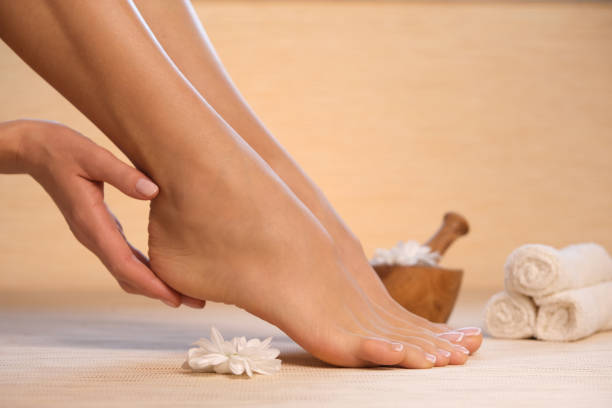In the United States alone, an astonishing number of cases involve people turning to cosmetic foot surgery, such as skin plasty, each year, seeking not just relief from deformity but also a pleasing aesthetic and better fitting shoes. Among these procedures, corn removal, including for hard corns and soft corns, stands out as a popular choice for those looking to step pain-free and with confidence, occasionally requiring minor surgery and stitches. This minor surgical stride on the bone corrects deformity and combines both visual appeal and functional gains, offering a dual benefit that resonates with the modern emphasis on well-being, beauty, and shoe compatibility.
Cosmetic foot surgery for corn removal and deformity isn’t just about vanity; it’s about reclaiming comfort, fitting into shoes better, and enhancing one’s quality of life through meticulous medical intervention.
Understanding Corns and Calluses on Feet
Corns Defined
Corns are small, round circles of thickened skin that form to protect sensitive foot areas from tight shoes. They often develop on the tops and sides of toes or between them. When your footwear doesn’t fit right, corns can appear due to pressure.
Calluses are larger than corns. They’re patches of tough skin that build up when friction occurs. Your feet might get calluses from walking a lot or wearing normal shoes without socks.
Causes Explored
Many factors contribute to these foot conditions. One major cause is shoes that do not fit well—either too tight or too loose. This leads to constant rubbing against the foot’s delicate parts.
Another reason could be skipping socks with certain types of footwear which increases friction. Also, high heels put extra weight on the toes and forefoot, leading to hardening of the skin there.
People with abnormal gait patterns may also see more calluses due to uneven weight distribution across their feet.
To prevent corns and callus formation:
-
Choose well-fitting shoes with enough room for toes.
-
Use protective pads in areas where rubbing occurs.
-
Keep feet moisturized daily to maintain soft skin.
Candidate Qualifications for Cosmetic Corn Removal Surgery
Ideal Candidates
Ideal candidates for cosmetic foot surgery, specifically corn removal, should meet certain criteria. Firstly, they must have a clear and persistent problem with corns that resists traditional treatments like padding or salicylic acid patches. These individuals often experience pain and discomfort from their corns, affecting their daily activities.
Good overall health is crucial for anyone considering this type of surgery. Patients should not have underlying health conditions that could complicate the healing process, such as diabetes or poor circulation. It’s also important that the candidate has no history of keloid scarring since this could affect the outcome of skin plasty procedures.
Realistic Expectations
Having realistic expectations is vital when undergoing any cosmetic procedure. Prospective patients should understand that while cosmetic foot surgery can alleviate pain and improve appearance, it may not result in perfect feet. Surgeons aim to enhance comfort and function rather than achieve aesthetic perfection alone.
Patients must be prepared for the recovery process after corn removal surgery. This includes time off from work and possibly limited mobility during healing. They should also be aware of potential risks associated with surgery such as infection or complications related to anesthesia.
Contraindications
Certain conditions can disqualify someone from being an ideal candidate for cosmetic corn removal surgery:
-
Active infections in the foot area.
-
Poor blood flow to the lower extremities.
-
Uncontrolled chronic diseases like diabetes.
These contraindications are taken seriously to ensure patient safety and optimal results post-surgery.
Overview of the Corn Removal Surgical Process
Pre-Surgical Prep
Before surgery, patients meet with their doctor. They discuss health history and any medications taken. This ensures safety during the procedure. The foot is then cleaned to prevent infection.
The surgeon may mark the corn’s location on the skin. This helps them remove it accurately during surgery.
Surgery Steps
On the day of surgery, patients relax in a comfortable setting. The surgical team prepares instruments for corn removal.
First, local anesthesia numbs the foot area. Patients stay awake but feel no pain in their foot.
Then, using precise tools, surgeons excise the corn and any underlying tissue causing pressure. After removing it, they clean and close up small incisions made during surgery.
Post-surgery care includes bandaging and instructions for recovery at home.
Minimally Invasive Techniques in Corn Removal
Surgical Advances
Modern medicine has made great strides in foot care. One area of significant progress is the treatment of corns through minimally invasive surgery. These advanced techniques involve smaller incisions, which means less damage to surrounding tissues.
Patients benefit from a quicker return to daily activities. They also face fewer complications compared to traditional surgery. For example, someone can have their corn removed and walk out of the clinic the same day.
Recovery Benefits
One major advantage of minimally invasive procedures is the shorter recovery time. Unlike open surgeries that require extensive healing periods, these methods allow for faster tissue repair.
This quick mending process reduces the risk of infection and other post-surgical issues. Patients often report feeling less pain during their recovery as well.
Scarring Reduction
Scars can be a concern for patients undergoing any type of surgery. With minimally invasive techniques, there’s a reduced chance of noticeable scarring after corn removal.
The minor incisions used in this approach heal more neatly than larger surgical cuts might do. This leads to smoother skin and better cosmetic outcomes overall.
Aftercare and Recovery Following Corn Removal Surgery
Essential Steps
After cosmetic foot surgery for corn removal, proper aftercare is crucial. You should keep the surgical area clean and dry to prevent infection. It’s also important to change dressings regularly as instructed by your doctor. Limiting movement and keeping weight off your foot can speed up healing. Use crutches or special footwear if recommended.
Your doctor may prescribe medication for pain management. Take these as directed. Watch out for signs of infection like redness, swelling, or unusual discharge.
Recovery Timeline
The recovery period varies but typically spans a few weeks. In the first week post-surgery, rest is key; you should avoid putting pressure on the foot. By the second week, you might start gentle walking with protective gear.
Most patients can return to normal activities within three to six weeks post-surgery, depending on their job or daily tasks’ physical demands.
Monitoring Signs
Be vigilant about potential complications during recovery from corn removal surgery:
-
Excessive pain that doesn’t improve with medication.
-
Signs of infection at the incision site.
-
Any numbness or tingling in the toes or foot.
-
Fever that could signal an underlying issue.
Contact your healthcare provider immediately if you notice any of these symptoms.
Pain Management and Comfort Post-Surgery
Pain Strategies
After cosmetic foot surgery for corn removal, managing pain is crucial. Patients often experience significant pain post-operation. Doctors may recommend over-the-counter pain relievers or prescribe stronger medication if needed. It’s essential to follow the dosage instructions carefully.
To help with discomfort, applying ice packs can reduce swelling and soothe the area. However, always wrap ice in a cloth to prevent skin damage. Elevation of the foot above heart level also helps minimize swelling and pain.
Proper Footwear
Wearing suitable footwear after surgery contributes significantly to comfort levels. Choose shoes that provide ample space for your toes and have soft cushioning to avoid pressure on sensitive areas where corns were removed.
Avoid tight or high-heeled shoes as they can put stress on your feet, leading to increased pain or even complications with healing stitches in soft tissue areas. Instead, opt for supportive sandals or slip-ons during recovery.
Activity Caution
It’s important for patients not to rush into normal activities too soon after their procedure; doing so might worsen their condition instead of improving it.
Light walking is often encouraged shortly after surgery under local anesthesia but listen closely to your body’s signals about what feels okay versus what causes discomfort. Stay clear from strenuous exercises like running until your doctor gives you the green light. Remember, each patient heals at a different pace so don’t compare your progress with others’.
Permanent Solutions and Prevention of Corn Recurrence
Surgical Outcomes
After managing post-surgery comfort, patients seek permanent solutions. Cosmetic foot surgery for corn removal can offer long-term relief. The procedure aims to remove the painful corn and address the underlying issue causing it.
Patients generally experience a high success rate with this surgery. It removes both hard corns and soft corns effectively. However, results may vary based on individual conditions and adherence to post-operative care.
Lifestyle Changes
To prevent new corns from forming, lifestyle changes are crucial. Here are some recommendations:
-
Choose footwear that fits well; tight shoes often contribute to corn development.
-
Use protective pads in areas where friction is common.
-
Maintain good foot hygiene and moisturize regularly.
These steps help maintain treatment area health post-surgery, reducing recurrence risks.
Follow-Up Care
Regular follow-up appointments play a key role in preventing recurrence of painful corns. During these visits, your doctor will monitor healing progress and can give personalized advice for your situation.
Follow-ups also allow for early detection if conservative treatment is needed again. Patients should be proactive about scheduling these important check-ins with their healthcare provider.
Choosing the Right Podiatrist and Surgical Center
Check Credentials
When seeking a podiatrist for cosmetic foot surgery to remove corns, credentials are crucial. Look for board certification in podiatry or orthopedics. This shows they have passed rigorous exams and meet high standards.
Ask about their experience with corn removal surgeries. A seasoned specialist can provide better outcomes. Research their educational background too. Top medical schools often mean quality training.
Facility Accreditation
The surgical center’s accreditation matters as well. It must adhere to strict health and safety standards. Before you book your procedure, inquire about the facility’s accreditation status.
Accredited centers undergo regular evaluations to ensure quality care is maintained. They should be forthcoming with this information if asked directly.
Patient Testimonials
Consider patient feedback seriously when choosing where to get your surgery done:
-
Read online reviews from previous patients.
-
Ask the clinic for success rate statistics.
-
Request before-and-after photos of past procedures if available.
Positive testimonials can indicate a trustworthy surgeon and facility.
Conclusion
Cosmetic foot surgery for corn removal isn’t just a walk in the park; it’s a step towards comfort and confidence. We’ve covered everything from understanding those pesky corns to ensuring you’re in the right hands for surgery. You now know what to expect before, during, and after the procedure, and how to keep those bothersome bumps at bay for good. With minimally invasive options available, getting back on your feet is quicker than ever.
It’s time to put your best foot forward. Don’t let corns cramp your style or hobble your happiness. Reach out to a trusted podiatrist and kickstart your journey to pain-free, pretty peds. Remember, you deserve to stride without strife!
Frequently Asked Questions
What exactly are corns and calluses on feet?
Corns and calluses are thick, hardened layers of skin that develop to protect areas on your feet from pressure and friction.
Who is a good candidate for cosmetic corn removal surgery?
Ideal candidates are those with painful or persistent corns not relieved by conservative treatments, in good overall health, and have realistic expectations about the surgery’s outcomes.
How is cosmetic foot surgery for corn removal performed?
The surgical process typically involves removing the core of the corn along with any underlying bony prominence that may be causing it. This can often be done using minimally invasive techniques.
What does aftercare involve following corn removal surgery?
Aftercare includes keeping the area clean, avoiding pressure on the foot, following your surgeon’s instructions for wound care, and attending follow-up appointments to monitor healing.
Can I expect pain after my cosmetic foot surgery for corn removal?
Some discomfort is normal post-surgery; however, your doctor will provide you with a pain management plan tailored to keep you comfortable during recovery.
Are there permanent solutions to prevent future corns after surgery?
Yes. The surgical procedure aims at providing a permanent solution by addressing the root cause of the corn formation. Your podiatrist may also recommend lifestyle changes or orthotics to prevent recurrence.
How do I choose the right podiatrist for my cosmetic foot surgery?
Look for a board-certified podiatrist experienced in performing cosmetic foot surgeries. Research their credentials, read patient reviews, and ensure they operate out of an accredited surgical center.





